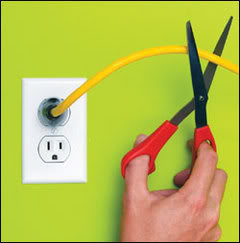380,000 US pay-TV subs cut cord in Q2
September 5, 2011
 The number of pay-TV households in the US declined by nearly 380,000 in the second quarter as traditional cable and satellite video providers continued to lose subscribers because of economic factors and lower-priced Internet video solutions, according to IHS Screen Digest.
The number of pay-TV households in the US declined by nearly 380,000 in the second quarter as traditional cable and satellite video providers continued to lose subscribers because of economic factors and lower-priced Internet video solutions, according to IHS Screen Digest.
Total US TV subscriptions in the second quarter decreased to 100.9 million, down from 101.4 million in the first quarter. These numbers encompass subscribers in three areas of the pay-TV business: cable, satellite video and IPTV.
Overall, the loss of approximately 378,000 households during the period was much greater than the increase of 345,000 seen in the fourth quarter of 2010. The decline also reversed much of the gains that occurred in the first quarter this year when some 461,000 subscriber households had signed on to new services. The last time a loss of this magnitude took place was a year ago in the second quarter of 2010, when the industry dropped approximately 249,000 subscribers.
The hottest topic in the industry, cord cutting – or the cancellation by subscribers of their cable or satellite video services – is often blamed for declining pay-TV subscriptions. In many instances, former pay-TV subscribers are opting for lower-priced Internet streaming solutions, offered by the likes of Netflix, Hulu and Amazon. Customers are also discontinuing video service in light of the difficult economic times.
Both the cable and satellite video segments of the pay-TV business suffered a net loss of subscribers. In the cable segment, exemplified by providers such as Comcast and Time Warner Cable, subscribers to–taled 59.6 million in the second quarter, down 635,000. The satellite video sector, populated by Dish and DirecTV, also saw the flight of some 109,000 subscribers during the period, down to 33.5 million.
The only sector to post gains was the IPTV space, thanks to Verizon FiOS and AT&T Uverse, whose subscriber numbers collectively reached 7.9 million, a net addition of 366,000. Under-penetrated at the moment, the IPTV segment is in the strongest position among the three TV sectors, with IHS Screen Digest predicting a 7.2 per cent compound annual growth rate until 2015. Still to be determined, however, is the effect of the current strike by Verizon workers on the bottom line of its FiOS service in the months to come.
The trend in which customers are discontinuing video service in favour of the Internet is particularly noteworthy in the current economic context, IHS believes. In better times, subscribers were happy to pay for either TV cable or satellite service, as well as for entertainment via the Internet. But when forced to choose, many appear to see greater value in the latter. Among cable outfits, for instance, the Internet component of their business expanded at the same time that their cable segments contracted. In the case of Comcast, the world’s largest cable operator, Internet subscribers grew by 101,720 compared to a loss of 238,000 for its cable operation. Overall, cable Internet subscribers increased by 270,000 in the second quarter to a total of 45.0 million.
For cable, the loss of business by providers in their traditional stronghold isn’t necessarily all bad news. While significant declines in video subscriptions are taking a toll on revenue, cable providers are also recouping losses via revenue from high-speed data and voice services, and cable operators remain in a unique position to adapt and grow their business.
Prospects are a little more muted for the satellite video segment. To be sure, DirecTV has been successful at capturing the high end of the market with its sports packages, while Dish has built its business on the back of cost-conscious consumers. Nonetheless, both face pressure from the declining demand for video packages, and a contraction in customers over time is inevitable.
